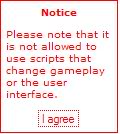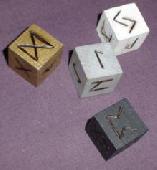-
Tue 5th Jan 2010 17:53 #1 / 54
I'd like to add a player stat which evaluates a player's aggressiveness. This would be expressed in a similar way to the G Rating (i.e. the normalised win ratio). I'm hoping that this can be calculated from the number of eliminations in a game of a given size.
This would be better than tracking just the number of players you eliminate which doesn't really mean a great deal.
Is anyone interested in working out the maths for this?
-
Tue 5th Jan 2010 18:20 #2 / 54This is getting ludicrous, Risky's kinda-a-big-dealness has gone airborne and infected my signature now too. Wear your masks, it's coming for you next!
You could arrange to have it work out as a percentage, from 0% to 100%. Since you're essentially making up a stat it doesn't have to be too complex, just the percentage of possible eliminations that you achieved. Something like:
Eliminated Players / ( Number of Players - Number of Boots - 1 ) * 100
-1 of course for yourself =]
That would give a per game, you could then either adjust them according to number of players in the game, or not worry about it and count each game as 1.
-
 Wed 6th Jan 2010 16:54 #3 / 54
Wed 6th Jan 2010 16:54 #3 / 54
I have worked out some things. Like 11s, I think we should not count booted players, so when I say "Number of Players", I mean number of non-booted players. Typically I denote "Number of Players" by n.
Now, if everyone is equally likely to be eliminated at any given time in the game and equally likely to be the one eliminating, the number of expected eliminations you make in a game is (n - 1)/n.
To derive this, note that there (n-1) eliminations in a game. Now, each player gets 1/n of all the possible eliminations. Thus each player averages (n-1)/n eliminations per game. As a check for this, note if we distribute (n-1)/n eliminations to each of the n players, we get (n-1) eliminations.
This is very surprising - in an 8-player game you should expect to eliminate 7/8 (< 1) players! While you have more opportunities to eliminate, there are more competing eliminators, and you are unlikely to retain the right to eliminate until the end.
So, we must adjust according to number of players. If we used 11s formula without adjusting, a person who only plays 4-player games eliminating twice the expected amount will have the same score as a person who plays only 8-player games but eliminates only the expected amount.
The normalized G-Rating style score would be calculated in this way: Per game, if a player eliminates k players, their normalized score is k*(n/n-1). Add the normalized scores and divide by number of games to obtain the "elimination score". If they average the expected (n-1)/n eliminations in n-player games, they get a score of 1. So > 1 is more eliminations than expected, < 1 is less.
In the next post, I'll argue that this does not measure aggressiveness and give an alternative stat.
In closing, I will state that I am extremely confident in these results, because I checked them in the space of possible "elimination sequences". Assuming equal likelihood for time of elimination and equal likelihood of eliminator, we can compute the averages by counting the number of eliminations for a specific player among ALL possibilities. For example, for 3 players, there are 3!2! sequences indicating who was eliminated (3 choices, then 2 choices, then 1) and who was the eliminator (2 choices, then 1 choice). Among the 12 possibilities, player 1 gets 8 eliminations, player 2 gets 8, player 3 gets 8. Thus each player has 8/12 = 2/3 eliminations per game.
-HughEdited Wed 6th Jan 16:54 [history]
-
 Wed 6th Jan 2010 17:04 #4 / 54
Wed 6th Jan 2010 17:04 #4 / 54
Don't forget Surrenders.
Also wouldn't it suck if you had someone down to 1 unit in a 2 player game and then they let themselves get booted? Seems like this could potentially promote jerks from allowing themselves to be eliminated but rather to just be booted.What's Your Passion? A cure? Three simple molecules? Building for the small? Compassion for children?
Seek Yours Today. Get Uncomfortable.
-
 Wed 6th Jan 2010 17:29 #5 / 54
Wed 6th Jan 2010 17:29 #5 / 54
Thanks guys, Hugh I look forward to seeing Part 2 :)
Yertle - I think this will be more of an ancillary (i.e. fun) stat so I don't think it's too much at risk from such behavior.
-
 Wed 6th Jan 2010 17:31 #6 / 54
Wed 6th Jan 2010 17:31 #6 / 54
The problem with the elimination stat we've been discussing is that it is strongly affected by skill! In the most striking example, Kobra Kai won 81% of his duels, and so would have eliminated more than expected in 2-player games. This isn't aggression, it's just good play. In general, good players stick around a while, and so will have more opportunity to eliminate, and merely by winning, they eliminate at least one player, so their "aggression stat" will always appear higher than weaker players.
I think a better headhunting stat is given by normalizing using not only the size of the game, but when a player left the game.
So, the thing to calculate is this: Given that the player was the k-th eliminated in an n-player game, what is the average number of players eliminated? An aggressive player will exceed this average, while a passive player will fall short of it.
Among games, where you are the first eliminated, you eliminate 0 players on average.
Among games where you are the second eliminated, you average 1/(n-1) eliminations per game (since there are n-1 competing to kill the first person).
Among games where you are the third eliminated, the average is 1/(n-1) + 1/(n-2) eliminations per game.
In general, you expect to eliminate 1/(n-1) + ... + 1/(n - k + 1) players per game [where k > 1]
Since this is a per game number, we can check this by adding these numbers together and checking that it gives the total number of eliminations in a game. To illustrate for 5 players, 1st player out expects to eliminate 0 per game, 2nd
player out 1/4 a player per game, 3rd player out 1/3 + 1/4, fourth player 1/2 + 1/3 + 1/4, 5th 1 + 1/2 + 1/3 + 1/4. In total (cleverly rearranging), we get 1 + 1/2 + 1/2 + 1/3 + 1/3 + 1/3 + 1/4 + 1/4 + 1/4 + 1/4 = 4, which is the number eliminated in a 5 player game.
So, with E = the sum described above, the normalized score for a player in a given game is:
(Number of players eliminated)/E. Once again, add the normalized scores from all the games for a player and divide by the total number of games. >1 is more aggressive, <1 less aggressive.
-HughEdited Wed 6th Jan 17:37 [history]
-
 Wed 6th Jan 2010 17:31 #7 / 54
Wed 6th Jan 2010 17:31 #7 / 54
tom wrote:
Yertle - I think this will be more of an ancillary (i.e. fun) stat so I don't think it's too much at risk from such behavior.Sounds good!
What's Your Passion? A cure? Three simple molecules? Building for the small? Compassion for children?
Seek Yours Today. Get Uncomfortable.
-
 Wed 6th Jan 2010 17:48 #8 / 54
Wed 6th Jan 2010 17:48 #8 / 54
Awesome stuff, thanks Hugh. I'll need to digest that properly but it seems to make sense.
So for a player who was eliminated third in a 6 player game and eliminates one other player, the calculation is:
1 / (1/5 + 1/4)
Is that correct?
-
 Wed 6th Jan 2010 17:50 #9 / 54
Wed 6th Jan 2010 17:50 #9 / 54
Last notes on coding the boundary conditions: The formula gives 0/0 for first player out, so either not updating 1st player out (my preferred, based on the no opportunity to kill in the "random" setting) or hard-coding a 0 for first player out (in reality, first player may have opportunity to kill) is the way.
Also, my formula gives 1/1 for the winner of a duel. The stat I think we're trying to measure shouldn't apply to duels, so hard-code it to ignore duels.
-
 Wed 6th Jan 2010 17:54 #10 / 54
Wed 6th Jan 2010 17:54 #10 / 54
tom wrote: Awesome stuff, thanks Hugh. I'll need to digest that properly but it seems to make sense.
So for a player who was eliminated third in a 6 player game and eliminates one other player, the calculation is:
1 / (1/5 + 1/4)
Is that correct?That is exactly right! Sorry it's not as straightforward as the other, but I think this is more accurate. I think we'll still see higher aggression values for stronger players, but my hope is that we'll get to see who the GMB's (lower headhunting value) are and who the Dingo's (considerably higher) are of Wargear!
-
 Wed 6th Jan 2010 18:51 #11 / 54
Wed 6th Jan 2010 18:51 #11 / 54
Hugh, I like the direction you're going, but here's one issue I see: in a 6 player game, someone who gets the first kill and then is eliminated next would get a score of 1/(1/5) = 5, whereas a player who gets the first two kills and then is eliminated next would only get a score of 2/(1/5 + 1/4) = 4.44. It seems counter-intuitive for your aggression measure to go down in this situation.
Edited Wed 6th Jan 18:51 [history]
-
 Wed 6th Jan 2010 19:30 #12 / 54
Wed 6th Jan 2010 19:30 #12 / 54
Would a measure of armies killed when attacking vs. armies killed when defending be a better measure of aggressiveness? I don't know that getting the finishing blow on opponents is a measure of aggression.
I find it more interesting to see total number of eliminations rather than average eliminations in games, people may stretch to eliminate you, when it's a strategically silly move to do because it pumps an artificial stat.
I would want an elimination counter simply so I can fight Gimli for elimiantion emails served. I have no idea where he is getting his number and I don't have any cheap replica axes to keep my own tally on.Cliffs notes: Aggressiveness should track who expands and who nests and waits for opponents to make moves, not who gets a last blow on an opponent.
BUT: Elimination stat - sure. This is like a games played stat. If you really want to track this stat and make it fair between games, break it down by game type.
3 player games avg 1.67 players/game (12 games played)
6 player games avg 3.2 players/game. (18 games played)
etc.
Then you can create some sort of normalized score if you like at the bottom, as well as a total eliminations stat.Edited Wed 6th Jan 19:37 [history]
-
 Thu 7th Jan 2010 02:30 #13 / 54
Thu 7th Jan 2010 02:30 #13 / 54
Andernut wrote:
Cliffs notes: Aggressiveness should track who expands and who nests and waits for opponents to make moves, not who gets a last blow on an opponent.
I was going with what tom seemed to mean in his original post by "aggressiveness" - I would agree that the term "aggressive" could mean something other than headhunting and I agree this would be measured by very different statistics.
By your wording ("who gets last blow"), you seem to be voicing the concern that the eliminator often falls upon his prize by luck. While this is true, my suspicion is that a small sample of games would be required to separate those who (wisely or not) like to eliminate other players from those who choose another route. And as it is a "fun stat" with no bearings on actual rankings, I can't imagine many people would target those with a high eliminator rating.
Your breakdown suggestion may be the way, as discussed next post :)
-
 Thu 7th Jan 2010 03:45 #14 / 54
Thu 7th Jan 2010 03:45 #14 / 54
Norseman wrote:
Hugh, I like the direction you're going, but here's one issue I see: in a 6 player game, someone who gets the first kill and then is eliminated next would get a score of 1/(1/5) = 5, whereas a player who gets the first two kills and then is eliminated next would only get a score of 2/(1/5 + 1/4) = 4.44. It seems counter-intuitive for your aggression measure to go down in this situation.
The development of this stat (as well as the first stat I posted) was based entirely on normalizing in the way the G rating does. I had no idea how strange it is to do such a thing until your post.
All of these ratings (G rating, the first post, the sum of reciprocals post) have some things in common: If you hit all of the expected percentages just right, you get 1. If you reproduce only one situation (e.g. 4 player games), you can recover percentages exactly (a G rating of 3 in the land of only 4-player games means a 75% winning percentage).
However, if game types (or situation types in the above case) are mixed, I think the G rating, as well as my suggested ratings, start to lose their meaning.
The above example you gave is a very convincing blow to the system I proposed (the frequencies I calculated are correct, but the overall method is flawed). The "G rating method" attaches a remarkableness to an event - 4 for winning a game you had a 1/4 probability of winning, 2 for winning a game you had a 1/2 probability of winning. The remarkablenesses are averaged for a seemingly logical score. Yet, averaging does not preserve remarkableness, and this is really the problem. Consider a player who wins a 2-player game followed by a 4-player game. His G rating is 3, yet the probability of doing that (assuming equal strength players) is 1/8. Already he has outperformed someone who won a 6-player game (1/6 probability - much easier). Now the other person worsens his performance further by losing a 2-player game. After two games they both have a G rating of 3.
So..... breakdown by game type is always a possibility (at which point, percentages and averages are just as informative as "normalized ratings"). I have other ideas, but this will wait for another day :)
-
 Thu 7th Jan 2010 08:11 #15 / 54
Thu 7th Jan 2010 08:11 #15 / 54
Who else took combinatorics in University? ;)
-
 Thu 7th Jan 2010 09:54 #16 / 54
Thu 7th Jan 2010 09:54 #16 / 54
Aggressiveness could be construed as the extent to which you utilize your units for attacks each turn, as opposed to keeping them in reserve or on defense.
There are a couple methods to calculate such a measure. For example, each turn you could take a straight percentage by dividing number of units that attacked by the number of units that were available for attack. This works perfectly in a simultaneous play game, but not so well for a versus game, due to the fact that if you attack with some units and win, they have the opportunity to keep attacking until they die or are all spent in occupying a territory (if abandon is off). To fix that, I suppose you could weight units that attacked multiple times (for example if you have a stack of 20 with which you swept through the board).
Alternatively, you could perhaps just take the ratio of attack dice rolled in a game compared to the total number of units available for attack, summing across all of a player's turns. This ratio would span 1, but I'm not sure that having an aggressiveness score of 1 would be especially meaningful, since it just means that you attacked once with each unit that was available for you to attack with each turn.
Another complication with an aggressiveness statistic calculated in this way is that it would probably have to be weighted according to the default board dice -- you would expect less aggressiveness on a board with default dice 6v8 than on a board with default dice 6v6.
-
 Thu 7th Jan 2010 10:00 #17 / 54
Thu 7th Jan 2010 10:00 #17 / 54
Andernut wrote:
I find it more interesting to see total number of eliminations
I wouldn't mind seeing something simple like this as well.
What's Your Passion? A cure? Three simple molecules? Building for the small? Compassion for children?
Seek Yours Today. Get Uncomfortable.
-
 Thu 7th Jan 2010 12:10 #18 / 54
Thu 7th Jan 2010 12:10 #18 / 54
Kjeld wrote: Aggressiveness could be construed as the extent to which you utilize your units for attacks each turn, as opposed to keeping them in reserve or on defense.
Yeah, I consider this to be more of a 'tactical aggressiveness' that would measure who likes to attack (I'd also win this stat) rather than the 'strategical aggressiveness' being discussed by Hugh as suggested by Tom (a stat which I'd win as well). As you note, there are pretty serious logistical obstacles to measuring the first...
An easy way to get past the dice odds issue would be to calculate this measure of aggressiveness as a per-game ratio and then combine them. WF's 'stats' tab displays the total # of dice rolled on attack and defense by each player. I like looking at it because I invariably end up rolling twice as many attack dice as the guy with the next highest total. It would be easy to say 'asm rolled 431 attack dice out of 1078 total attack dice rolled in a 4-player game, or 40%, which is +15% over the expected average.' Then you could either sum that 15% differential from game to game, or average it.
The larger problem would be controlling for eliminations (if I win a 4-player game I'm obviously going to have rolled many more attack dice than at least 2 players and probably the 3rd, and this problem worsens as games get bigger), which I can't think of a way to get around other than to simply stop counting when the first elimination occurs.
Anyway I think the other stat, once the <strike>nerds</strike> smart people figure out how to count it, will be more fun anyway.Cramchakle wrote: [anything]
I agree
-
 Thu 7th Jan 2010 14:27 #19 / 54
Thu 7th Jan 2010 14:27 #19 / 54
Aggressiveness could be easily put in as number of units you lost while attacking divided by number of units lost total.
Everybody gets a percentage. If you lost 80% of your units while attacking, then you were aggressive for 80% of the time. This doesn't imply any type of skill at the game, you can all-out attack then die, just like you could hole up and die, but can determine what type of player someone is when tabulated across many games.
You could give titles to people based on their level of aggressiveness.
Player Aggressiveness Titles -->
Stays close to home
The armies belong in the homelands!
What standing army?
Bullier of nations
Suicidal GeneralWhatever, make them fun, let them denote aggressiveness, and say something about the person's playing style. They're just fun stats right? Why get complicated.
There's no reward for being more or less aggressive, it's just a play style, so the complications needn't get overly complicated.
Same goes for eliminations - there's no competition on a per-game basis, it's just an interesting statistic. Total eliminations = 112 works for me too.
Edited Thu 7th Jan 14:41 [history]
-
 Thu 7th Jan 2010 14:44 #20 / 54
Thu 7th Jan 2010 14:44 #20 / 54
Yertle wrote:
Andernut wrote:
I find it more interesting to see total number of eliminations
I wouldn't mind seeing something simple like this as well.
That's pretty straightforward to add at least... my head is spinning about the rest. Hugh I'm not sure where Norseman's post leaves your proposed system, is it dead in the water?
Andernut you're right in that I was equating eliminations with aggressiveness, it really should be a head hunter rating rather than an aggressiveness rating.
I think we could do some per game analysis about aggressiveness based on something like Andernut's idea, I wonder if it would be possible to carry this over to a global stat (i.e. across all games for an individual player)? If not it's not the end of the world.
Edited Thu 7th Jan 14:44 [history]
















